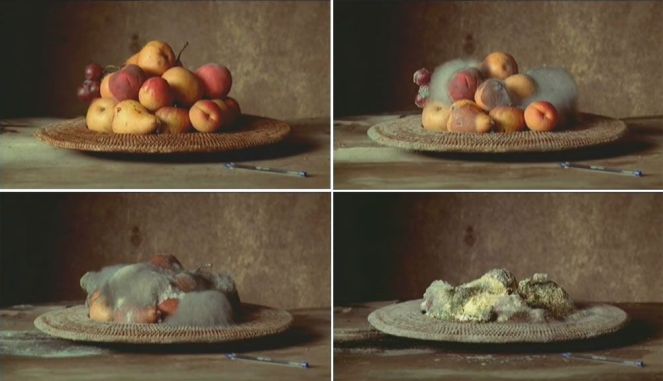
Initial Reaction
Sam Taylor Wood’s Still Life is a video time-lapse that depicts a bowl of fruit decaying. My first reaction to it was mostly one of disgust since mouldy fruit isn’t exactly aesthetically pleasing, however, it’s also weirdly fascinating. I do wonder where this was done as it’s not something you’d want in your house that’s for sure.
Media and Form
Fruit is often used in art, though this is a different take on it – I think the fact that she chose something natural reflects how we can’t control the decaying process and in a way, this also links to the inevitability of death.
Still life art is usually a stationary piece of art like a painting and this could have been done in a series of paintings too. The decision to do this as a time-lapse in video form allows you to physically see the decaying process and how time affects it, which I feel prompts more of a reaction.
Context
This piece resembles a Vanitas painting since fruit is a common symbol for the pleasures of life. Similarly, the decaying process links to the theme of death and mortality that is significant to Vanitas art. The juxtaposition against the natural fruit decaying and the plastic pen remaining in good condition is a reflection of the environment and world. These artificial items will be the things left when we are no longer here since no living thing can escape the inevitability of death.
Taylor-Wood also has another time-lapse piece that shows a dead hare that gradually decomposes alongside a peach. Again, this shows how fleeting biological life is and forces the idea of death on us. I immediately think of Damien Hirst’s work with regards to this theme – the shark in particular as he also puts death on show like this and forces the audience to contemplate the control it has over living things. Tacita Dean is another artist that physically shows the passing of time with the use of nature (mosquito, birds, baby crying).
Time
This piece links to time since the choice to use video means you can literally see time passing and how it causes the fruit to decay. In a wider sense, this conveys how short biological life actually is in regards to how much time passes within the universe.
__________________
I wasn’t overwhelmed by the time-lapse, without knowing it’s a ‘piece of art’, I wouldn’t call it one – a similar reaction I had to Hirst’s shark. I think Taylor-Wood wants us to contemplate complex themes like death, decay and time, rather than being as direct with a dead shark she uses something delicious and aesthetic. You can’t help but watch the decaying and essentially death of the fruit alongside the mould taking over and coming to life, showing the effects of time and how living things can’t withstand it. The pen seems random but when watching the video it’s condition doesn’t deteriorate and you face the reality of our environment and how these artificial objects that we control are what will remain when time and death takes control of us.
It’s interesting to see how the fruits decay at various rates which is much like other forms of biological life. As humans, we all meet an inevitable death but have no control over the time it takes. Sometimes you see people’s health deteriorate (like the fruit) but often this isn’t the case and we’re reminded of our mortality and how fleeting life can be.
With contextual information, I do have a better understanding of it. By choosing to declare this as a work of art, it makes you stop and question why and what it’s representing which is powerful and the purpose of all art – the artist wants you to experience and have a reaction to something, what that is, depends on the viewer.

